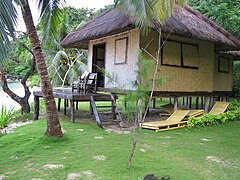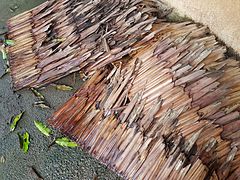

Amakan, also known as sawali in the northern Philippines, is a type of traditional woven split-bamboo mats used as walls, paneling, or wall cladding in the Philippines.[1] They are woven into various intricate traditional patterns, often resulting in repeating diagonal, zigzag, or diamond-like shapes. The term "sawali" is more properly defined as twilled weaving patterns. The term can also be applied to baskets and banig (soft woven mats made from pandan leaves, buri palm straw, abaca, or sedges), which also use the same weaving patterns.[2][3] Amakan panels are commonly confused with pawid (nipa panels), which are made from thatched leaves.
Amakan are used as walls in the traditional nipa huts (bahay kubo) of the Philippines. They are lightweight and porous, allowing air circulation to keep buildings cool in the hot tropical climate. The porosity also balances pressure inside the house during strong winds, minimizing roof damage.[4] Amakan needs to be treated before installation. They are soaked in seawater, dried, and then usually (but not always) varnished. They are usually affixed to a wooden framework, then battened with bamboo or coco lumber.[5]
Amakan is associated with lower income rural housing because it is inexpensive and easy to replace. It is not uncommon for amakan to also be used as a design element (usually as cladding or paneling) in modern Filipino architecture to portray a rustic, traditional and tropical aesthetic.[4][6][7] It also ecologically sustainable because it is made with bamboo.[5]
Similar traditions
Pawid

A simpler method of making panels from leaves is called pawid, which is simply thatching. It predominantly uses nipa palm leaves, and is the origin of the name of the nipa hut. But it can also use other materials like coconut leaves, anahaw leaves, and even cogon grass. They are made by simply folding the leaves once around a split bamboo stick and then sewing them together near the base. They are most commonly used as roofing, with the panels layered over each other so the water runs down the leaves and away from the inner roof. They are constantly replaced as the panels get damaged.[8][9]
Sulirap
A similar weaving tradition is called sulirap, surilap, or salirap among Visayans;[10][11] and sulirap, selirap, or sayrap among the Tausug, Yakan, and Sama-Bajau people. It uses an entire coconut palm leaf split lengthwise along the midrib (rachis). Then both halves are positioned with the leaflets in between them. The leaflets are then intricately woven into various patterns and designs to join the two split parts together. This results in a lengthwise woven panel with the split midrib providing the upper and lower border. It is used similarly as amakan and sawali: as cheap walls, roofs, awnings, or temporary shade. This method, modified slightly, can also be used to make traditional baskets.[12][13]
Gallery
-
A rural house in Aklan with plain amakan walls
-
A rural house in Leyte with amakan sidings woven into diamond patterns
-
A gift shop in Bohol with amakan walls
-
A traditional Filipino house with amakan walls in Bohol
-
Sawali interior paneling in the Mabini Shrine, a traditional Filipino house (bahay kubo)
-
Amakan open-type weaving style used as grilles
-
Preserved traditional house of President Manuel L. Quezon's parents in Baler, Aurora. It uses pawid (nipa thatch) as both roofing and walls.
-
Damaged thatched nipa panels (pawid)
See also
References
- ^ "Batuan SLPA produces amakan for local and national trades". GOVPH. Department of Social Welfare and Development, Republic of the Philippines. Retrieved 23 April 2021.
- ^ Miller, Hugo H.; Minier, John F.; Andes, U.S.; Muller, Theodore; Brezina, Alice (1913). Philippine Mats. Philippine Craftsman Vol. I, No. 1. Manila: Bureau of Printing.
- ^ Parker, Luther (1914). Some Common Baskets of the Philippines. Philippine Craftsman Vol. III, No. 1. Manila: Bureau of Printing.
- ^ a b "Use of Indigenous Filipino Materials and Methods in Building Green Homes". Buensalido Architects. Retrieved 23 April 2021.
- ^ a b Plywood (PDF). Global Shelter Cluster. October 2014.
- ^ "Can't get enough of the 'tiny house' bahay kubo? Check out this modern amakan house". GMA News Online. 25 August 2020. Retrieved 23 April 2021.
- ^ "An Old Fashioned Pinoy Bahay Kubo In Palawan". RealLiving. 7 September 2017. Retrieved 23 April 2021.
- ^ Alarcon ·, Norma (1991). Philippine Architecture During the Pre-Spanish and Spanish Periods. Santo Tomas University Press. p. 30. ISBN 9789715060400.
- ^ Nazarea-Sandoval, Virginia D. (1989). Philippine Rural Cultivators in Transition Operational Reality and Cognized Models in Agricultural Decision Making. University Press of Kentucky. p. 89.
- ^ Tantuico, Francisco Sypaco (1964). Leyte: The Historic Islands. Leyte Publishing Corporation. p. 65.
- ^ Hamilton-Peterson, James (1987). Playing with Water Passion and Solitude on a Philippine Island. New Amsterdam Books. p. 271. ISBN 9780941533829.
- ^ Mua, Moneia M. "Cultural Diversity Among the Bangsamoro in Mindanao: A Survey of their Traditional Arts". Budayaw. Retrieved 8 December 2023.
- ^ Sakili, Abraham P. (2003). Space and Identity Expressions in the Culture, Arts and Society of the Muslims in the Philippines. University of the Philippines. p. 266. ISBN 9789718992135.
External links
 Media related to Amakan at Wikimedia Commons
Media related to Amakan at Wikimedia Commons

















